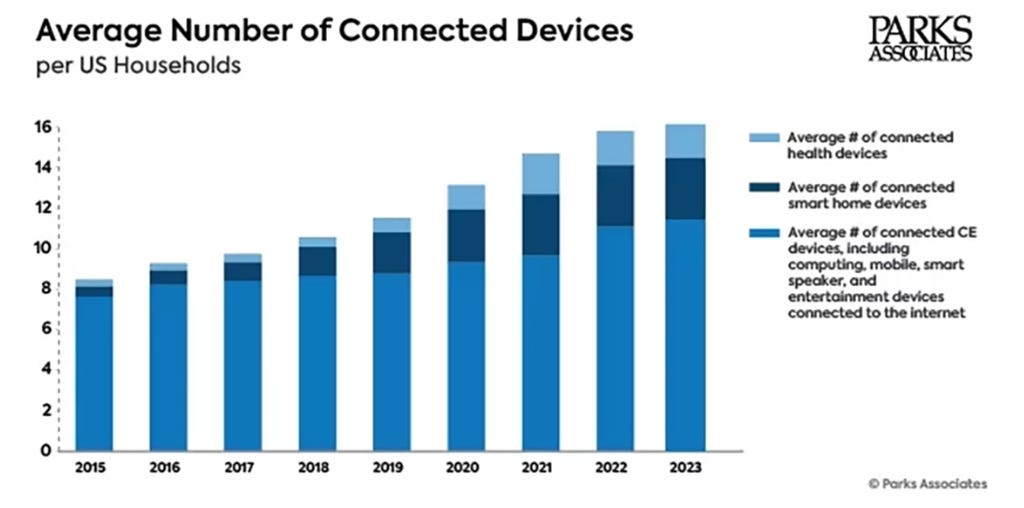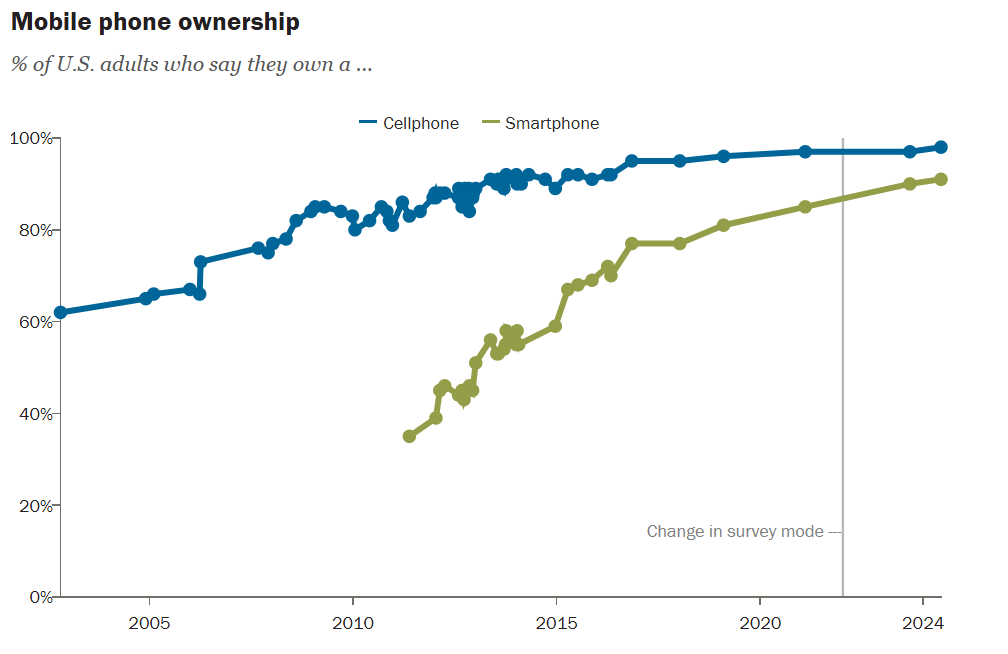DIGITAL INSIGHTS: The Role People and Their Devices Play in Data Center Proliferation
We are undergoing a change not seen since the Industrial Revolution. Data centers are driving it. And people are driving the demand.
By Martin Davis
EDITOR-IN-CHIEF
Email Martin

Digital Insights is a new weekly feature appearing on Thursdays that explores the role of data centers in our region. These columns will focus on four areas: tracking the development of data centers in our area, exploring projected and actual tax revenue trends, explaining what data centers are and how they affect our daily lives, and reporting on research and emerging trends in the industry. These columns are made possible, in part, by a grant from Stack Infrastructure.
Among the many concerns rightly raised about data centers is the amount of energy required to power them. The challenge is, indeed, significant. And the advent of artificial intelligence (AI) is pushing the power needs of data centers to significantly higher levels.
“In 2023,” wrote Mahmut Kandemir, a professor of computer science and engineering at Penn State University about the pressure AI is putting on energy production, “data centers consumed 4.4% of U.S. electricity—a number that could triple by 2028.”
While numbers like these rightly raise concerns, what is often lost is an understanding of what’s driving the proliferation of data centers and, thus, the increase in power. The answer, it turns out, is fairly simple. Us.
Professor Andrew Chien of the University of Chicago explains the growth of data centers this way. “They’re growing very fast because of just increased use of the digital world—so called digitalization of society, commerce, social interaction, and so on.” (See Chien’s explanation of the growth of data centers in the following 2-minute video clip from SciLine.)
Chances are, one needn’t look far in their own homes to see the devices that are requiring us to build more data centers.
According to Parks Associates, the average home now has 17 internet connected devices in the home.
But it’s not just devices. It’s the applications that we use on these devices.
To better understand how personal devices are driving data center development, the Advance highlights three devices, services, and applications that are commonly used by people in the U.S. today.
Netflix
Number of Subscribers worldwide: 301.6 million paid subscribers
Number of US Subscribers: 81.44 million
Netflix is the largest streaming service in the world, and it depends on Amazon World Services for “online storage, a recommendation engine, video transcoding, databases, and analytics,” according to an article on CloudZero.com.
Every day, according to one study, Netflix users stream 203,840,000 hours of content. And that streaming happens because of data centers. How much energy does it take?
It’s a difficult question to answer and has created considerable controversy. An early estimate done by the Shift Project estimated that the carbon output created by streaming a 30-minute video was equal to driving a gasoline-powered car 20,604 feet. That study was proven to be in error. A newer estimate by the Sauber Project puts the total at 460 feet. (For a full discussion of this controversy, see “Data Center Power: Is Netflix Really Contributing to Climate Change?”, and “The State of Streaming Sustainability 2024.”)
That’s a relatively modest number. However, a detailed analysis of Netflix and other major streaming services published in 2024 by Greenly, which helps companies measure their carbon footprint, notes that it’s the sheer scale of streaming that has the greatest impact on energy use.
Some back of the envelope map demonstrates the point.
If 30 minutes of streaming is the equivalent of driving 460 feet in a gasoline powered car, then an hour is equal to 920 feet. That number multiplied by 203,840,000 hours of streaming content is 187,532,800,000 feet, or 35,517,575 miles driven in a gasoline powered car.
“Scale of streaming,” indeed.
Smart Phone
Number of Subscribers worldwide: About 7 Billion
Number of US Subscribers: About 320 Million
Smart phone growth has been rapid. According to Pew Research, 98% of Americans now have smart phones. That’s up from just 35% in 2011.
The impact of smart phones on the growth of data centers is hard to underestimate. We demand that our phones be on and responsive on demand. This is possible only because of data centers.
Forbes magazine, writing about the demands people have for phone performance, put it this way in a 2024 article.
… what’s perhaps obvious to folks in the IT industry that people outside the industry may be oblivious to is that all these phones depend on data centers located somewhere in the world, perhaps nearby, but most likely not. In other words, it’s not about the phone per se; it’s about the interconnected network because both phone and network must be working to bring users the experience they have come to expect.
Bottom line, according to Forbes, “Our increased use of smartphones contributes to data center growth, which McKinsey estimates will grow 10% a year through 2030.”
Google Maps
Downloads: 10 Billion
It’s become difficult to imagine life without online navigation tools. Whether one is in a strange city trying to get from point A to point B, looking for a nearby restaurant or gas station and directions to it, or just wants to know how long it will take to arrive at a destination, navigation tools like Google Maps are what we turn to.
And Google Maps, the most-used navigation app in the world, functions because of data centers. How much do we use Google Maps?
A 2024 article, “37 Google Maps Statistics and Interesting Facts,” by Center.ai provides some perspective.
In 2019, 67% of all smartphone users utilized Google Maps
On average, users engage in 50 sessions with Google Maps each month, each lasting about 3 minutes, marking it the second most used navigation app. Waze Navigation Live & Traffic (which is also owned by Google) leads with an average of 269 minutes per user monthly, while Apple Maps usage lags significantly at just 12 minutes.
Google Earth’s comprehensive database houses more than 40,000 terabytes of geospatial information and includes historical images and scientific data accumulated over three decades.
Google Maps receives updates at a remarkable rate of 200 contributions per second, amounting to 200 million pieces of data from users every day, ensuring constant currentness.
Typically, Google Maps consumes an average of 2.19 megabytes (MB) of data hourly, and for every mile traveled, it uses about 67 kilobytes (KB) of data.
Data centers are what make navigation apps work. And as with smart phones, it’s the sheer volume of use that puts pressure on companies to build out additional data centers.
Takeaway
There is a saying, “May you live in interesting times.”
We certainly do.
The digitalization of life that we are all witnessing is on par with, if not potentially more significant than, the other great revolutions in human history — the First Agricultural Revolution, the invention of the printing press, and the Industrial Revolution.
All these changes were disruptive and created significant challenges that had to be solved.
It’s no different today. Data centers are the engines that drive the tools that the world’s population now depends on for entertainment, communication, and navigation — and that’s just a tiny fraction of the digitalization that data centers drive.
The disruption caused by digitalization brings enormous challenges. The energy to power data centers is one of those challenges, and it is one that will require ongoing innovations.
It’s important to remember, however, that this explosion in digitalization and the data centers that drive them is due to the tools we rely on.
Local Obituaries
To view local obituaries or to send a note to family and loved ones, please visit the link that follows.
Support Award-winning, Locally Focused Journalism
The FXBG Advance cuts through the talking points to deliver both incisive and informative news about the issues, people, and organizations that daily affect your life. And we do it in a multi-partisan format that has no equal in this region. Over the past year, our reporting was:
First to break the story of Stafford Board of Supervisors dismissing a citizen library board member for “misconduct,” without informing the citizen or explaining what the person allegedly did wrong.
First to explain falling water levels in the Rappahannock Canal.
First to detail controversial traffic numbers submitted by Stafford staff on the Buc-ee’s project
Our media group also offers the most-extensive election coverage in the region and regular columnists like:
And our newsroom is led by the most-experienced and most-awarded journalists in the region — Adele Uphaus (Managing Editor and multiple VPA award-winner) and Martin Davis (Editor-in-Chief, 2022 Opinion Writer of the Year in Virginia and more than 25 years reporting from around the country and the world).
For just $8 a month, you can help support top-flight journalism that puts people over policies.
Your contributions 100% support our journalists.
Help us as we continue to grow!
This article is published under Creative Commons license CC BY-NC-ND. It can be distributed for noncommercial purposes and must include the following: “Published with permission by FXBG Advance.”















This feature will be very helpful as our area continues to add multiple data centers. Thank you, Fredericksburg Advance.
The Following FXBG Council Candidates are taking a campaign donation from the #1 Attorney for DATA CENTERS in the region (Fredericksburg, Caroline, Spotsy, and Stafford), Charlie Payne (source: VPAP, Virginia Public Access Project):
Ward 1 (vote Hugh Mercer ES): MATT ROWE $500.
Ward 2 (vote Dorothy Hart CC): JOY CRUMP (in-kind donation of house party for campaign; may appear in the next report period for VPAP);
Ward 3 (vote Gladys West ES, same bldg, different name): SUSANNA FINN $1000.
Do NOT Early Vote on Sept 19. There are issues in the city 22401 that are under investigation but may knock off a candidate(s) from the LOCAL ballot. Wait it out for now to see what happens in the next weeks.